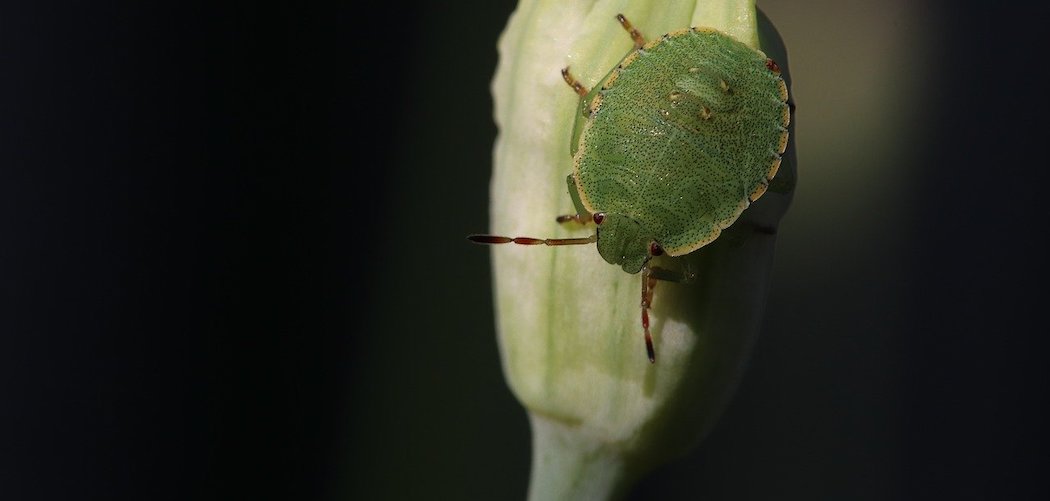Have you recently found stink bugs in your home and worried about their possible impact on your houseplants?
You should be!
In this article, we will explore how bad stink bugs can be for houseplants and tell you exactly how you can get rid of them.
Firstly, Here’s if Stink Bugs Can Harm or Kill Your Houseplants:
Yes, some kinds of stink bugs can be harmful to houseplants. They feed on the sap and will bite the stem of the houseplants to get at it, scarring the plant. Small infestations are unlikely to do much damage, but if they feed on it heavily, stink bugs could kill a houseplant.
However, there are many species of stink bugs and some can even be beneficial. Luckily, we’ve compiled all the answers you need to know:
1. Which Stink Bugs Hurt Houseplants? Green, Brown Marmorated, etc.
Yes, stink bugs can be harmful to houseplants, but not all of them are – so let’s explore the different kinds.
Green Stink Bugs
Green stink bugs live on plant sap and plant leaves, so yes, they can be harmful to your houseplants. They will eat any plant that they find, piercing the stems to drink the liquid contained within.
Green stink bugs do not tend to enter homes and they are therefore unlikely to damage your houseplants, but it may happen.
If a green stink bug is lingering on your plants, relocate it outdoors promptly.
Brown Marmorated Stink Bugs
Brown marmorated stink bugs tend to prefer to eat fruits and vegetables to plants.
They may get into your fruit bowl and pierce the foods there, or they may attack any fruiting plants that you have, but they are rarely a danger to houseplants.
These are an agricultural pest and generally only enter homes during the winter.
If you find one during the cold months, it is more likely to be hibernating, rather than looking for things to eat.
These do not generally pose a threat to houseplants.
Brown Stink Bugs
This term usually refers to the Brochymena stink bug, which is unfortunately similar to the brown marmorated stink bug in appearance and often gets confused with it.
You can distinguish it from the similar brown marmorated stink bug because the Brochymena has spines on its shoulders.
Brochymena stink bugs are a species of stink bug that is a friend to gardeners, and will not harm your houseplants.
Instead, it will feed on problematic insects, freeing your plants from pests and keeping them safe.
It is unlikely that you will see it on your houseplants, but if you do, it’s best to leave it where it is.
Gray Stink Bugs
Gray stink bugs are not actually a separate species, they are either the brown marmorated stink bug or to the Brochymena stink bug.
Try to determine which you are dealing with to check whether it is a friend or foe.
Look out for the shoulder spines for your best clue!
2. Do Stink Bugs Eat Houseplants?
Yes, many kinds of stink bugs eat houseplants and can look frustratingly similar to those that don’t. If you find either green stink bugs or brown marmorated stink bugs in your home, they may be preying on your plants.
This is particularly true if your plants are looking sick and you can see marks on the stems or foliage.
If you find sticky sap, this is a further sign that your plants are under attack.
Sometimes, you can actively invite them without knowing.
For example, if you have houseplants such as miniature orange trees that may produce fruits, the brown marmorated stink bug will thoroughly enjoy that.
There are also stink bugs that prey on insects instead of plants and can actively help you fight pests.
However, most stink bugs that feed on insects will not be found in your home, as the pickings will be slim inside a house.
If you see brown marmorated stink bugs in your home during the winter, it is likely that they are looking for a place to hibernate, rather than plants to prey on.
However, in the summer, the appearance of stink bugs on your houseplants should concern you, yes.
3. Do Stink Bug Larvae Eat Houseplants?
Yes, the larvae of many stink bugs will feed on plant matter, just like their parents. The larvae may live in or around your houseplants so that they can get an easy meal, and they can be very heavy feeders.
What they look like will vary depending on the kind of stink bug that you are dealing with.
For example, the young of a brown marmorated stink bug will be yellow to begin with, slowly fading into white. They have bright red eyes, and will gradually shed their skins until they become as large as their parents.
If you see these around your houseplants, they are probably feeding on them, and you need to take action.
Take a look further down on how to actively get rid of them.
4. Do Stink Bugs Live In Houseplants?
Stink bugs don’t usually live in houseplants because they choose to stay in places where they are unlikely to be disturbed. They will only live in your houseplant if they feel that the foliage is dense enough to provide enough cover and shelter.
Large houseplants with thick leaves may provide stink bugs with a shelter, but this is relatively unlikely.
In most cases, stink bugs will only come inside briefly during the summer, and will live outdoors for most of the time.
In winter, stink bugs may move into your home for warmth, but it is unlikely that they will take up residence in your plants.
They will instead find a dark, quiet, undisturbed spot and rest until the weather warms up.
Do Stink Bugs Live In The Soil Of Your Houseplants?
No, stink bugs are not digging insects and will not live in your houseplants containers. They are flying insects that are not particularly well adapted to burrowing, so the soil will be too hard and too wet for them.
In general, they will live outdoors in decomposing leaf matter, under dead plants, or among decaying wood.
5. Do Stink Bugs Lay Eggs On Houseplants?
Yes, stink bugs may occasionally lay their eggs inside and on houseplants. The eggs are usually pale green, yellow, or brown, and they will generally be laid on the underside of a leaf or on a stem.
You might find clusters of eggs in the soil or on the stems of your plants, especially if you have left plants undisturbed for significant periods.
Stink bugs need to find a ready and easy source of food for their young to eat when they hatch, and a houseplant may provide this, particularly if it offers shelter and safety from predators.
This is obviously concerning if you don’t want millions of baby insects crawling around your home and infesting your plants.
Different stink bugs have different habits, but many will lay eggs on plant matter.
So, it’s a good idea to occasionally check the leaves of your plants and the soil around them for any eggs, especially if you know you have had stink bugs in your home.
If you discover any, it is best to remove them before they have time to hatch.
6. How To Get Rid Of Stink Bugs In Your Houseplants
If you have stink bugs persistently attacking your houseplants, you will need to take action before they do enough damage to hurt your plant seriously. Spraying all the leaves of your plant with a standard commercial bug killer or insecticide will be very effective.
Although there are great natural methods, you may still want to use a chemical repellent to kill the stink bugs as these are very effective.
It is best to take your plant outside for this so that you aren’t spraying potentially harmful chemicals in your home.
Cover your face and avoid breathing in the spray, as it could be harmful.
Allow your plants to stand outside for a while before you bring them back in, as this will give the spray time to take effect and evaporate.
You may need to repeat this treatment, so keep an eye on the plant and see if the stink bugs come back.
However, stink bugs are not like other infestations, such as aphids, which actually live on the plant.
In general, they will feed a bit and then move on to the next one, so you probably won’t need to treat your plants – especially if the stink bugs are not living in your home.
How To Naturally Get Rid Of Stink Bugs In Your Houseplants
One of the best natural solutions to get rid of stink bugs is to create a garlic spray. These bugs hate the smell of garlic, and will avoid any plants that have been sprayed with it.
To do this, you need to boil some water and chop some cloves of garlic into it.
Let it steep and cool, and then strain out the liquid and spray it onto your plants (make sure it is room temperature first).
This should deter stink bugs and many other predatory insects, because the smell of the spray is strong and unpleasant to them.
You may also be able to rub down the leaves with neem oil, and this should kill eggs as well as adult insects.
It is safe for use on plants and generally a very effective insect killer, and is preferable to strong, chemical sprays that could be harmful to other wildlife too.
Final Thoughts
Stink bugs will rarely kill or even significantly damage your houseplants, but many of them are plant predators and could pose a threat.
If you see stink bugs on your houseplants, identify first to understand how much of a threat they are.
Then, get rid of them and don’t forget to look under the plant’s leaves for eggs.

